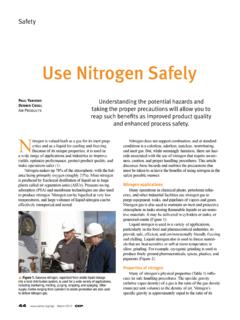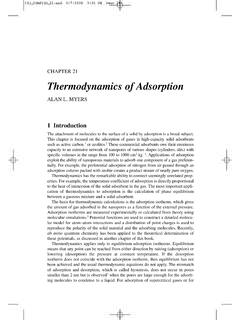Transcription of Use Nitrogen Safely - Air Products
1 44 March 2012 CEPS afetyNitrogen is valued both as a gas for its inert prop-erties and as a liquid for cooling and freezing. Because of its unique properties, it is used in a wide range of applications and industries to improve yields, optimize performance, protect product quality, and make operations safer (1). Nitrogen makes up 78% of the atmosphere, with the bal-ance being primarily oxygen (roughly 21%). Most Nitrogen is produced by fractional distillation of liquid air in large plants called air separation units (ASUs).
2 Pressure-swing adsorption (PSA) and membrane technologies are also used to produce Nitrogen . Nitrogen can be liquefied at very low temperatures, and large volumes of liquid Nitrogen can be effectively transported and stored. Nitrogen does not support combustion, and at standard conditions is a colorless, odorless, tasteless, nonirritating, and inert gas. But, while seemingly harmless, there are haz-ards associated with the use of Nitrogen that require aware-ness, caution, and proper handling procedures.
3 This article discusses those hazards and outlines the precautions that must be taken to achieve the benefits of using Nitrogen in the safest possible manner. Nitrogen applications Many operations in chemical plants, petroleum refin-eries, and other industrial facilities use Nitrogen gas to purge equipment, tanks, and pipelines of vapors and gases. Nitrogen gas is also used to maintain an inert and protective atmosphere in tanks storing flammable liquids or air-sensi-tive materials. It may be delivered in cylinders or tanks, or generated onsite (Figure 1).
4 Liquid Nitrogen is used in a variety of applications, particularly in the food and pharmaceutical industries, to provide safe, efficient, and environmentally friendly freezing and chilling. Liquid Nitrogen also is used to freeze materi-als that are heat-sensitive or soft at room temperature to allow grinding. For example, cryogenic grinding is used to produce finely ground pharmaceuticals, spices, plastics, and pigments (Figure 2).Properties of Nitrogen Many of Nitrogen s physical properties (Table 1) influ-ence its safe handling procedures.
5 The specific gravity (relative vapor density) of a gas is the ratio of the gas density (mass per unit volume) to the density of air. Nitrogen s specific gravity is approximately equal to the ratio of its Understanding the potential hazards and taking the proper precautions will allow you to reap such benefits as improved product quality and enhanced process YaniskoDennis CrollAir ProductsUse Nitrogen Safelyp Figure 1. Gaseous Nitrogen , vaporized from onsite liquid storage into a local distribution system, is used for a wide variety of applications, including blanketing, inerting, purging, stripping, and sparging.
6 Other supply modes ranging from cylinders to onsite generation are also used to deliver Nitrogen March 2012 45molecular weight to that of air (MWN2/MWair = 28/29 = ). A specific gravity less than 1 indicates that the gas is lighter than air and will rise, while a specific gravity greater than 1 indicates that the gas is heavier than air and will tend to settle. Nitrogen gas is only slightly lighter than air and readily mixes with air at room temperature. Cold vapors are more dense and will settle.
7 Liquid Nitrogen , a cryogenic liquid, has a very low boil-ing point of 320 F. As indicated by its high liquid-to-gas expansion ratio, liquid Nitrogen produces large volumes of Nitrogen gas when it hazards of Nitrogen Nitrogen is sometimes mistakenly considered harmless because it is nontoxic and largely inert. However, it can act as a simple asphyxiant by displacing the oxygen in air to levels below that required to support life. In addition, Nitrogen gas stored in pressurized containers and systems is stored energy that can cause serious injury or death if released in an uncon-trolled manner.
8 Liquid Nitrogen also presents hazards due to its extremely low temperature and large expansion ratio. Oxygen deficiency Nitrogen can displace oxygen in the air, reducing the percentage of oxygen to below safe levels. Because the brain needs a continuous supply of oxygen to remain active, lack of oxygen prevents the brain from functioning properly, and it shuts down. Being odorless, colorless, tasteless, and nonirritating, Nitrogen has no properties that can warn people of its pres-ence. Inhalation of excessive amounts of Nitrogen can cause dizziness, nausea, vomiting, loss of consciousness, and death (Table 2).
9 Death may result from errors in judgment, confu-sion, or loss of consciousness, which prevent self-rescue. At extremely low oxygen concentrations, unconsciousness and death may occur in seconds and without warning. The Occupational Safety and Health Administra-tion (OSHA) considers any atmosphere with an oxygen level below to be oxygen-deficient and immediately dangerous to life or health. Personnel should not enter an area where the oxygen concentration is below unless they are using self-contained breathing apparatus (SCBA) or a supplied-air respirator.
10 If the atmosphere s oxygen content falls to between p Figure 2. Liquid Nitrogen is used in certain particle-size-reduction pro-cesses to super-refrigerate material, including pigments, plastics, powder coatings, waxes, pharmaceuticals, nutraceuticals, spices, and other food Products . Liquid Nitrogen makes a material more brittle, allowing it to be easily broken up into small particles using less 1. Physical and chemical properties of Formula N2 Molecular Weight Point @ 1 atm F ( C)Freezing Point @ 1 atm F ( 210 C )Critical Temperature F ( C)Critical Pressure psia ( atm)Density, Liquid, @ Boiling Point, 1 atm lb/scfDensity, Gas @ 68 F (20 C), 1 atm lb/scfSpecific Gravity, Gas (air = 1) @ 68 F (20 C), 1 atm Gravity, Liquid (water = 1) @ 68 F (20 C), 1 atm Volume @ 68 F (20 C)





